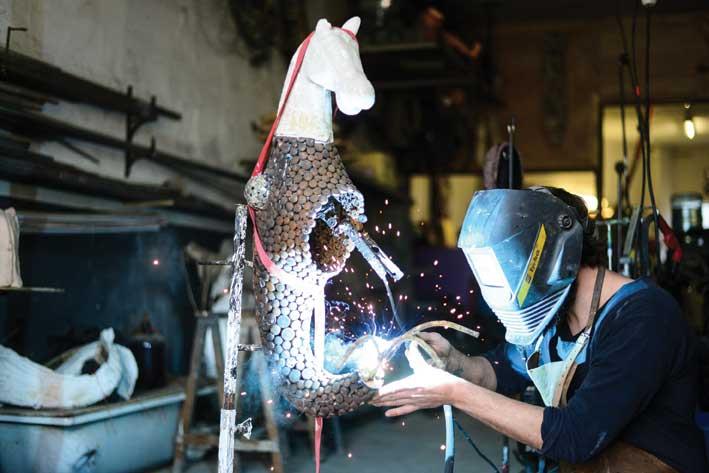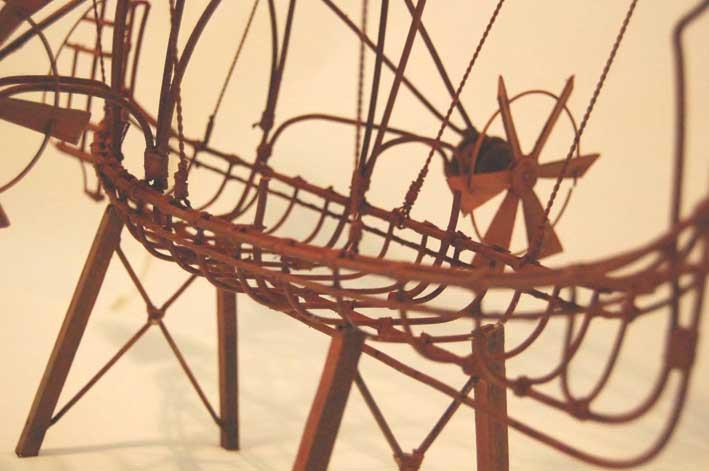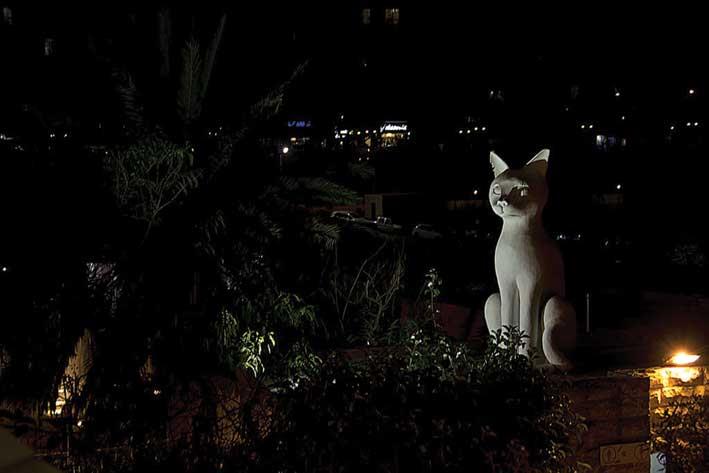When I decided to interview Matthew Pandolfino for this month's article, the idea was to get some insight into the world of a young blacksmith. The end result, however, turned out to be something completely different.
Trying to pigeonhole Matthew into a solitary category, profession, artistic style or medium is a fruitless endeavour. He is, to all intents and purposes, a multi-talented creator, capable of seeing the potential of turning almost anything into either a work of art or something completely different and certainly more useful than its individual, component parts.
Perhaps one way of describing 'Pan' - as he is affectionately known to his friends - is as a chimera of sorts, a hybrid of something like Leonardo Da Vinci and MacGyver, with a small measure of elf or pirate thrown in for good measure.

I met Pandolfino close to the centre of Zebbug and followed him and Rusty, the medium-sized puppy of the same complexion as his namesake, down the winding, mostly dirt, track out of the village to his workshop. All the way there, through my windscreen, I could see Rusty's head, tongue out, hanging outside the window of the old van enjoying the gentle breeze of an unusually warm Sunday afternoon in January.
The workshop is surrounded by countryside, with only the hills a short distance away adding some diversity to a seemingly unspoilt green landscape. Rusty wastes no time in making full use of the wide, open space and quickly disappears into the foliage.
The garage is practically a curiosity or antique shop in its own right and makes use of one of the oddest yet highly structured organising methods I've ever come across. Brass wind instruments on one shelf, high voltage equipment on another, recovered metal work, metal light fixtures and so on and so forth.

Over a cup of coffee, with Pandolfino sitting on a steel rocking-chair made of recycled architectural features - bits of railings, balconies and a section of an I-beam - we begin our interview.
Although Pandolfino works mostly with metal, his material of choice is whatever he finds available. Whether it is scavenged, salvaged, foraged, bartered or bought, anything could become a part of his next work.
When I ask him if he considers himself a blacksmith, he laughs and tells me he'd like to be, but is quite a long way from developing the full array of techniques needed to do justice to such a title. There are almost no real blacksmiths left locally - at least in the traditional sense - but there are, however, a lot of people who know how to work metal. Considering that when people used to go to a blacksmith to get a door made, the same craftsman would also make the lock and key, that level of expertise is practically non-existent now.

Sadly, some craftsmen are particularly territorial - afraid that if they pass on the knowledge and skills they possess, the recipient might pose a threat and eat away at their already small client base. Pandolfino recounts one story, where one of his teachers admitted that he had omitted a section of the process to his students out of fear that they'd start copying him. The ultimate result of any craftsman not passing on his trade is that of contributing to its eventual demise.
Behind me is a half-finished large iron seahorse awaiting completion, patiently welded together from metal off-cuts full of rivet holes.
Pandolfino recalls how it was his parents who first ignited his creativity. They had a philosophy that would make most parents nowadays cringe: they figured that in order to reduce the chances of him hurting himself while creating something and using tools, they might as well teach him how to use them appropriately rather than forbid him from using them at all.
Pandolfino and his brother used to make their own toys. Whatever they saw and liked on television they replicated, not only for themselves but also for their local friends. Matthew's formal qualifications stem from a degree in Fine Arts from Darlington College of Arts, where he specialised in kinetic sculpture, but his most important learning experiences are those his parents taught him and whatever he learnt himself.

When you make use of any medium at your disposal, you have to learn. One day you can be sewing a costume for a play and the next making a giant fibreglass cat. You never know where the creative process is going to take you - it depends to a degree on whatever you find.
One significant advantage we have nowadays is that we can learn almost anything through the internet, a source Pandolfino frequently makes use of for whatever needs to be learnt. The only downside is that you don't get feedback on what you could have done better.
He admits that his style is certainly more visual then conceptual, as he constantly seeks to create beautiful, aesthetically pleasing things, whatever they may be. He can nowadays confidently call himself an artist.
"It's not always easy, committing yourself to being a full-time artist. Sometimes there are rough financial patches you have to wade through, but just because you encounter one of them doesn't mean you just stop being an artist. »
«There have been times when I've had to take a job as a waiter just until I sorted out some things. The jobs I've taken when things got tough were always a temporary gig. Art is my profession, not the other way round. Some of the best advice I've ever been given is to just keep doing it."
This year Matthew will be embarking on his biggest project to date, Id-Dħajsa Tar-Riħ a seven square metre interactive steel sculpture paying homage to port transport, among other things. The piece is one of six selected following a public competition held by the Transport and Infrastructure Ministry, the Justice, Culture and Local Government Ministry, Arts Council Malta and Heritage Malta. The winners were selected as the result of a vote that was open to the public.
Despite it being the most challenging project so far, Pandolfino is already concerned about how he's possibly going to trump it with something even better after it is finished.
As we are nearing the end of our interview, I ask 'Pan' if there is anything in particular he would like our readers to know about. He mentions two things: the first is his giant cat on top of the public conveniences at Independence Gardens in Sliema. The cat was supposed to be a blank canvas on which other artists could draw, paint or spray, and the fact that people haven't covered it up in colours is quite disappointing to him. So if any of you painters out there want to show off your skills, please consider a giant cat as your canvas.
The second thing is the desperate need for tools and additional work space for artists in Malta. With so many resources in schools and colleges being used only during school hours, he feels that artists should be allowed to make use of some of the equipment available at the MCAST Art and Design College during the weekends and evenings.